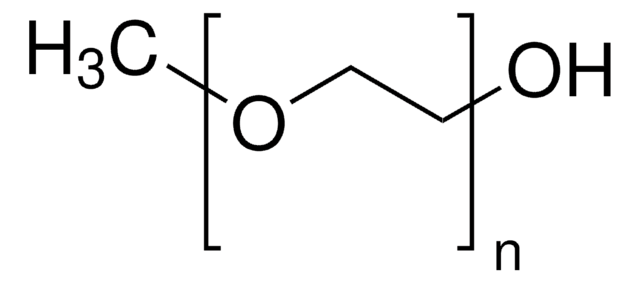84797
Poli(etilenglicole)
BioUltra, 2,000
Sinonimo/i:
PEG
About This Item
Prodotti consigliati
Livello qualitativo
Nome Commerciale
BioUltra
Forma fisica
powder
PM
Mr 1900-2200
Impurezze
insoluble matter:, passes filter test
≤0.001% peroxides (as H2O2):
pH
5.5-7.0 (25 °C, 50 mg/mL in H2O)
Punto di fusione
50-53 °C
Solubilità
H2O: 50 mg/mL at 25 °C, clear, colorless
Anioni in tracce
chloride (Cl-): ≤50 mg/kg
sulfate (SO42-): ≤50 mg/kg
Cationi in tracce
Al: ≤5 mg/kg
As: ≤0.1 mg/kg
Ba: ≤5 mg/kg
Bi: ≤5 mg/kg
Ca: ≤10 mg/kg
Cd: ≤5 mg/kg
Co: ≤5 mg/kg
Cr: ≤5 mg/kg
Cu: ≤5 mg/kg
Fe: ≤5 mg/kg
K: ≤200 mg/kg
Li: ≤5 mg/kg
Mg: ≤5 mg/kg
Mn: ≤5 mg/kg
Mo: ≤5 mg/kg
Na: ≤200 mg/kg
Ni: ≤5 mg/kg
Pb: ≤5 mg/kg
Sr: ≤5 mg/kg
Zn: ≤5 mg/kg
λ
50 mg/mL in H2O
Assorbanza UV
λ: 260 nm Amax: ≤0.1
λ: 280 nm Amax: ≤0.04
Stringa SMILE
C(CO)O
InChI
1S/C2H6O2/c3-1-2-4/h3-4H,1-2H2
LYCAIKOWRPUZTN-UHFFFAOYSA-N
Cerchi prodotti simili? Visita Guida al confronto tra prodotti
Descrizione generale
Applicazioni
- as a constituent in the preparation of liquid desiccant solutions
- as a precipitating agent and additive in protein crystallization
- as a representative biocompatible polymer to decipher its interactions with cellular system at molecular level
Codice della classe di stoccaggio
11 - Combustible Solids
Classe di pericolosità dell'acqua (WGK)
WGK 1
Punto d’infiammabilità (°F)
281.5 °F - closed cup
Punto d’infiammabilità (°C)
138.6 °C - closed cup
Dispositivi di protezione individuale
Eyeshields, Gloves, type N95 (US)
Certificati d'analisi (COA)
Cerca il Certificati d'analisi (COA) digitando il numero di lotto/batch corrispondente. I numeri di lotto o di batch sono stampati sull'etichetta dei prodotti dopo la parola ‘Lotto’ o ‘Batch’.
Possiedi già questo prodotto?
I documenti relativi ai prodotti acquistati recentemente sono disponibili nell’Archivio dei documenti.
I clienti hanno visto anche
Il team dei nostri ricercatori vanta grande esperienza in tutte le aree della ricerca quali Life Science, scienza dei materiali, sintesi chimica, cromatografia, discipline analitiche, ecc..
Contatta l'Assistenza Tecnica.
